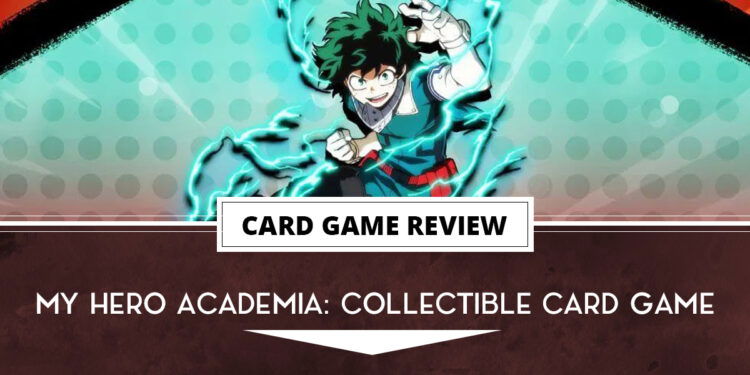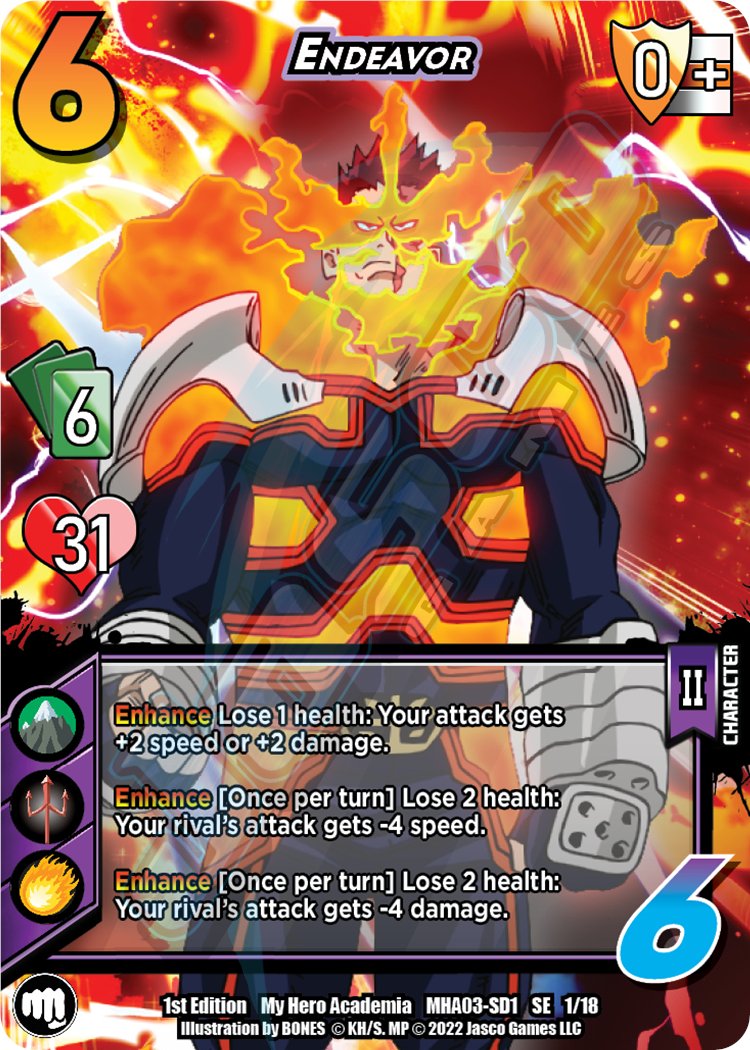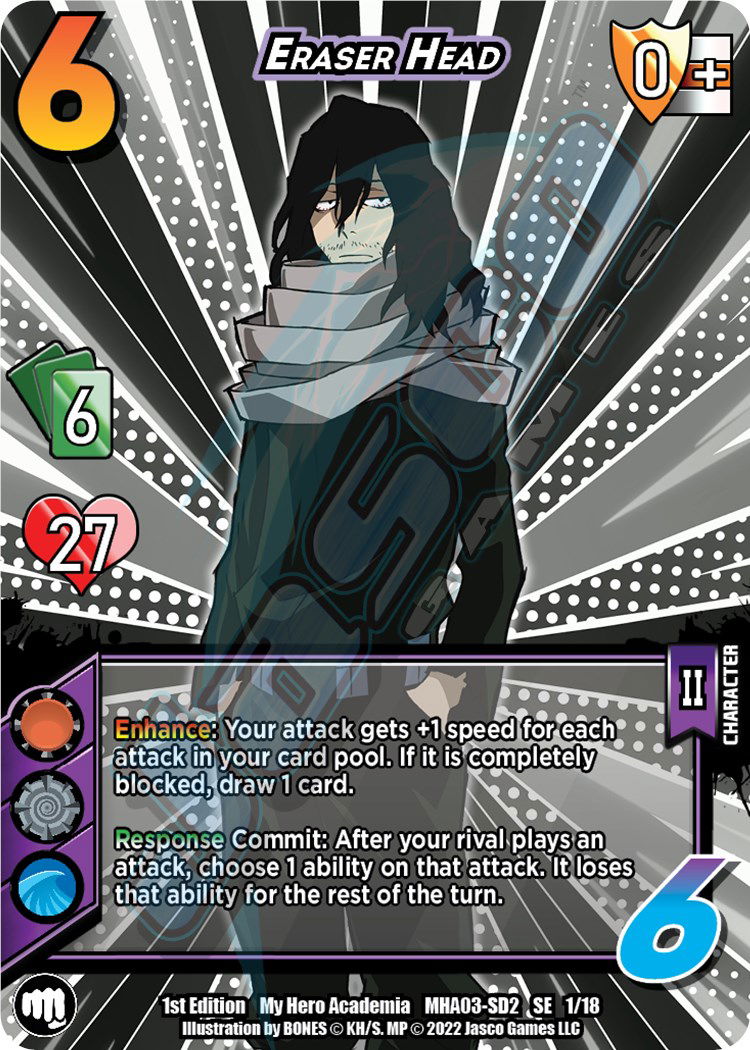There are a plethora of card games out there for you to choose from. You could play Magic: The Gathering, Hearthstone, Shadowverse, Teppen, Pokemon, Yu-Gi-Oh, and so many others… but why would you? You’re a My Hero Academia fan! Well, you’re in luck because they, too, have a collectible card game for you to play and they also have new decks coming out to expand upon their already deep set with the Heroes Class sets!
Title: My Hero Academia CCG: Heroes Clash
Publisher: Jasco Games
Release Date: October 21, 2022
Price: $19.95 (Starter Deck)
My Hero Academia: Collectible Card Game goes the traditional route with physical cards. That means that, yes, you will have to interact with other human beings to play this game; however, there is a benefit here in the fact that the game is built upon the Universus system so if you’ve played other franchises within that system, you already know how to play this game… but… what if, like me, you haven’t?
The Learning Curve
Having played several card games before, I have a bit of an edge so I ended up understanding how the game works rather quickly but even with that experience, the Universus system does things a bit differently than I’m used to so there was a learning curve attached.
The biggest question one might have is… “is it easy to pick up and play?”
Well, it took me watching a couple of videos on how to play but it is rather easy once you see a practice game shown.
First off, unlike games like Magic and Hearthstone, you don’t have any mana to cast your cards. In this game, you have a Difficulty rating and a Check. Say, the difficulty of a card is 2. When you play that card, simply flip over the top card in your deck. If the Check value in the bottom right is 2 or higher, it resolves and the card is played successfully. If it’s 1, then it doesn’t check and your card isn’t played. Also, your turn is over at that point. There is a way around that but we’ll get to that in a second.
There are two types of cards (well four, but we’ll take about the most important two here). Foundation Cards and Attack Cards. Foundation Cards should be played first and have relatively low difficulties so they are almost always guaranteed to check and get played. At the end of your turn, these Foundation Cards go to the bottom of your game board, known as the Stage. These cards can act as “Mana” in a sense. So, let’s say you have a card with a difficulty of 5. When you flip a card over, you see the check value is 4. If you have a foundation card in your Stage, you can commit the card (aka, turn it sideways… also known as tapping in other games) and add +1 to your Check. That would make your Check 5 and it will allow you to play the card. Some of these foundations have Enhances on them (effects) so if you commit them, be warned that you cannot use that card’s effect
Attack cards work the same way with a twist. A card has an attack value. This is straightforward. This is how much damage a card will do to your opponent. However, each card has a Speed value and a Defense value. The speed determines what type of attack it is. Think of it like a fighting game. There are High, Mid, and Low. A card’s Defense value will also show High, Mid, and Low as well. High Defense fully blocks High attacks, Mid blocks Mid, and Low blocks Low. However, Adjacent levels will block, too, but only half the damage so… if you attack High and your opponent uses a Mid defense to block, they will take half damage…. IF it passes the check.
To perform the check, add the speed and defense values together, flip a card and compare. You can commit more cards (including your character card… more on that in a minute) if you need to increase your check value at the sacrifice of their effects being usable.
Now comes the Character Card. The Character Card has a hand size value and a health value. Hand size tells you how big your hand can be. If it’s six, then you will always draw cards at the start of your turn until you have six cards. If the health on a card is 30, that is your life total. You can never go above your life total and once it hits 0, you lose.
The Character Card also has three elements on it. This is important when you build your deck because you can only include cards that contain those elements. You can put cards in your deck if you have just one of the three listed. Like in Magic, you are allowed to have up to four copies of a card in each deck you build.
Combat
I briefly explained combat above with attacks, speed, and defense, but in this phase, you keep attacking as long as you can keep playing cards. The combat phase ends when either your opponent is dead or you cannot play any more cards and both you and your opponent agree to take no more actions. You MUST have 2 consents, one from each player, to take no action before the turn ends.
The good news here is that cards that successfully attack don’t go to your discard pile. Instead, they get flipped over and stuck under your character card. They become a new resource called Momentum. Some cards will say if an ability can trigger if you use Momentum. There are even decks built around this mechanic.
As for the full game, there are three phases. The first is where you draw your cards. You can decide to discard a card if you don’t like it and then draw until you have max hand size. Then there is the combat phase where cards are played, attacks happen, defense happens, and so forth. Then there is the end phase where you stock your Momentum, discard any other cards, and clean up your board. When you run out of cards in your deck, you take your discard pile, shave off 10 cards, and start over. You get 50 cards to play with so as you can imagine, you only have five deck cycles before you hit 0 cards and automatically lose when that happens.
That is the basic gist of the Universus system. There are other card types out there and a few more rules to follow but the basics should carry you through a few of your first games. While it sounds like a lot and can be a bit confusing, it’s easy to understand once it’s all seen.
Endeavor and Eraser Head Decklists
Asmodee games sent me two new starter decks. Here is what you get in each one!
Endeavor Deck
1x Character Card: Endeavor Version II
1x Attack Card: Prominence Burn
1x Foundation Card: Soul-Piercing Glare
3x Attack Card: Hellflame Punch
2x Attack Card: Flame Scourger
2x Attack Card: Blazing Fury
2x Attack Card: Arctic Conflagration
2x Attack Card: Scorching Aura
3x Attack Card: Ignited Arrow
2x Attack Card: Hellflame Stomp
4x Foundation Card: Thrilled Spectator
4x Foundation Card: Stare Down
4x Foundation Card: Quick to Act
4x Foundation Card: Press Conference
4x Foundation Card: Fast as a Flame
4x Foundation Card: Coping With #1
4x Foundation Card: Arrogant Smirk
4x Foundation Card: Unnerving Energy
1x Attack Card: Fierce Whirlwind
Eraser Head Deck
1x Character Card: Eraser Head Version II
1x Attack Card: Total Erasure Binding
1x Foundation Card: Prone to Dry Eyes
2x Attack Card: Aerial Drop
2x Attack Card: Binding Cloth Drop Kick
2x Attack Card: Binding Cloth Precision
3x Attack Card: Binding Cloth Whiplash
3x Attack Card: Binding Shoulder Rush
2x Attack Card: Erasure Grasp
2x Attack Card: Roundhouse Exhaust
4x Foundation Card: Acrobatic
4x Foundation Card: Binding Cloth Mastery
4x Foundation Card: Closing In
4x Foundation Card: Daunting Message
4x Foundation Card: Dedicated Instructor
4x Foundation Card: Dropping in from Above
4x Foundation Card: Exhausted Exclamation
4x Foundation Card: Patient Observation
1x Attack Card: Somnambulism
Does it Look Good?
There are two types of players when it comes to card games. Those who look at a card’s stats first and those who look at a card’s artwork first. No matter which one you are, you’re still going to look at the art and silently (or vocally) judge the card’s aesthetics.
With this being based on the anime, the artwork for each card stays true to the show. In the decks I was provided, each card was in full color and high resolution. All of your favorite characters were there such as Endeavor, Eraser Head, Todoroki, Iida, Midnight, and others. All of the art looked about as official as can be and each different card had characters in unique poses so no shortcuts with reusing art.
Just like in any CCG, you have special cards, and MHA:CCG is no different. There were a few… cards that had a foil/reflective sheen to them which looked very nice. It’s always special to pop open a pack and see a shiny high-production card with extra effort and detail put into it
Final Verdict
There is a bit of a learning curve but after doing a couple of practice matches while following the rules, it took me about 2 games to put away my cheat sheet and play a full game through without having to look up anything. I would say that it’s pretty intuitive and fun to play.
Being a My Hero Academia fan, I loved how the cards stayed true to the characters in the show. Everything from the artwork to the card names, to some of the abilities were themed very well and fit the type of deck you were playing. For example, just naming a card Arctic Conflagration and having Todoroki on it fit the theme of his quick, Half Hot, Half Cold. Of course, anyone who knows anything about Eraser Head can easily tell which cards are his in the deck just by the names alone.
If you’re a fan of card games and a fan of My Hero Academia (or Boku no Hero Academia for those who prefer subs over dubs), I can safely say that you’ll have a fun time with this game. There are a lot of other decks out there for you to pick up including favorites such as Midoriya and Bakugo. You can buy them in 50-card packs which will include an entire starter deck for you to play with. Again, as long as cards have the same elements as your character card, you can mix and match and build custom decks.
There is a lot of depth and strategy to the game with meaningful choices along the way. So, pick it up, try it out, and discover a new way to enjoy My Hero Academia!
**These decks were provided for review by Jasco Games




